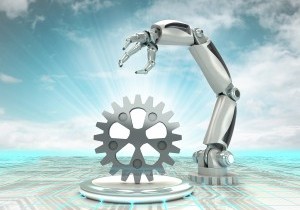The Rise of Automation and Robotics in Supply Chains
On “Star Trek: The Next Generation,” Captain Jean-Luc Picard often pondered the week’s signature conundrum over a cup of comfort.
“Tea. Earl Gray. Hot,” he’d say to the Replicator, and a moment later it would materialize.
We’re not quite there just yet, but at this year’s Consumer Electronics Show in Las Vegas, we got one giant step closer with the debut of COOKI, the prototype for a robot that, in conjunction with an app that knows what fresh ingredients are available in your fridge, can present a list of recipes that work within those parameters and bring it all together right there in your kitchen.
“I love to cook,” says Henrik I. Christensen, Ph.D., “but I’m sure I would give it up for a machine that will do it for me. It’s very cool!”
Christensen is the KUKA chair of robotics at the College of Computing at Georgia Institute of Technology and the executive director of the Institute for Robotics and Intelligent Machines. He collaborates with the likes of Apple, BMW, Electrolux and others. “Very cool” is a pretty stellar review.
It might be a decade or more before COOKI’s robotic arm is whipping up a staff lunch in your warehouse’s break room, but its bigger, burlier cousins will likely be out on its floor well before then. Robotics and automation is moving forward at veritable light speed, and the laws and regulations governing their use are finally catching up to the technology.
In 2015 robots will not only be streamlining the process and facilities of the supply chain, they’ll be working right alongside their human co-workers (and keep right on going when everyone else heads home for dinner).
Robots as job creators?
“At the end of the day,” says Christensen, “people want to have more agility in their supply chain, to send materials with very little storage, very rapid reaction, very high speed.”
Robotics, he says, is about empowering people to do just that. Though some workers are wary that automation will do away with their jobs, Christensen says more often than not, robots merely shift employees to other positions. Generally, better ones.
“The automotive industry did not buy robots to replace people, they did it to get consistent quality, which allowed them to grow.”
“Robots enhance the workplace,” says Scott Melton, regional manager of MHI member FANUC Robotics America. “And robotics takes people out of hazardous environments—places where they are palletizing, loading them onto ATVs. It eliminates strenuous jobs where the risk of injury, whether immediate or over time due to repetition, is very high.”
Jobs that both he and Christensen say most people don’t want to do, anyway.
“High turnover is one of the supply chain’s biggest challenges,” Christensen points out. “The good news is that when we install a robot, it will work 24/7 and it could be 10 years before you have to do anything for it.”
Helping companies produce and/or deliver goods faster, says Melton, allows them to be competitive and grow. He cites FANUC client Noble Plastics, a Louisiana-based operation that has continued to expand—and hire—as they’ve implemented robotic automation. FANUC also helps Noble train employees to work in the new environment.
Click here to read the full article.





